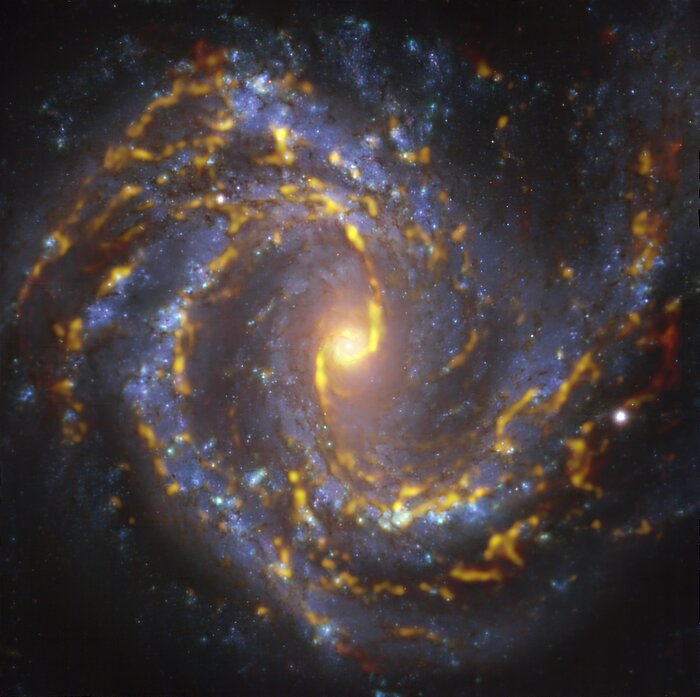A hypnotising galaxy
Fall deeper into the entrancing NGC 4303, a spiral galaxy located approximately 55 million light-years from Earth in the constellation Virgo. This image combines data taken at radio and visible wavelengths, and is helping astronomers understand how stars form in galaxies.
The hypnotising golden glow drawing you into the image corresponds to clouds of molecular gas, the raw material out of which stars form. The data was taken with the Atacama Large Millimeter/submillimeter Array (ALMA), co-operated by ESO in the Chilean Andes. The blueish regions in the background, on the other hand, were imaged with the Multi-Unit Spectroscopic Explorer (MUSE) instrument on ESO’s Very Large Telescope (VLT), also in Chile, and they reveal already formed stars. By comparing the distribution of gas and stars astronomers are able to study what triggers, enhances or hampers the birth of new stars.
This image is part of the Physics at High Angular resolution in Nearby GalaxieS (PHANGS) project, which is using ground-based and space telescopes to make detailed observations of nearby galaxies across the electromagnetic spectrum
Crédit:ESO/ALMA (ESO/NAOJ/NRAO)/PHANGS
À propos de l'image
| Identification: | potw2306a |
| Type: | Observation |
| Date de publication: | 6 février 2023 09:00 |
| Taille: | 888 x 884 px |
À propos de l'objet
| Nom: | NGC 4303 |
| Type: | Local Universe : Galaxy : Type : Spiral |
| Distance: | 55 million années lumière |
| Constellation: | Virgo |
| Catégorie: | Galaxies |
Fonds d'écran
Coordinates
| Position (RA): | 12 21 54.89 |
| Position (Dec): | 4° 28' 24.88" |
| Field of view: | 2.96 x 2.95 arcminutes |
| Orientation: | North is -0.0° left of vertical |
Couleurs & filtres
| Domaine | Longueur d'onde | Télescope |
|---|---|---|
| Visible G | 475 nm | Very Large Telescope MUSE |
| Visible R | 625 nm | Very Large Telescope MUSE |
| Millimétrique CO [2–1] | 1.2 cm | Atacama Large Millimeter/submillimeter Array Band 6 |
| Visible I | 775 nm | Very Large Telescope MUSE |

